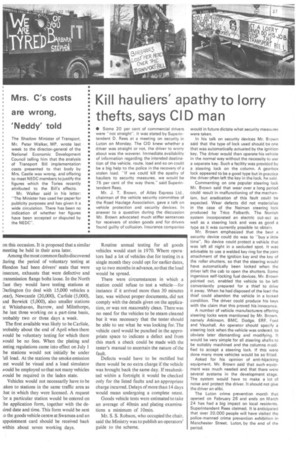Overflow for test-tips meeting
Page 28

Page 29

If you've noticed an error in this article please click here to report it so we can fix it.
by Ashley Taylor • There was no question of the MoT testini stations running a sort of league table or defects discovered. The sole object of th( procedure was to enhance safety said Mr C. C. Toyne, superintending engineer, Minis try of Transport, in reply to questions at Newcastle upon Tyne meeting last week.
Minor defects could be corrected by the driver in the test lane provided the work dic not hold up the general progress, he said If necessary, adjustments could also be math in the testing station park. While the test wa! going on an owner's representative could bo present.
Over 600 members of the road transpor industry, some of whom were accommodate( in an overflow room, attended the rrteetim which was arranged by the North Easter' regional maintenance advisory committee Over 100 who proposed to come from Tees side were asked not to crowd the meetiril on this occasion. It is proposed that a similar meeting be held in their area later.
Among the most common faults discovered during the period of voluntary testing at Hendon had been drivers' seats that were insecure, exhausts that were defective and .ransmission flange bolts loose. In the North east they would have testing stations at 3arlington (to deal with 15,000 vehicles a fear), Newcastle (20,000), Carlisle (5,000), md Berwick (5,000), also smaller stations it Whitehaven, Barrow, and Milnthorpe, he last three working on a part-time basis, )robably two or three days a week.
The first available was likely to be Carlisle, )robably about the end of April when there vould be voluntary testing for which there would be no fees. When the plating and .esting regulations came into effect on July 1 :he stations would not initially be under 'till load. At the stations the smoke emission .est would be visual and a load simulator Nould be employed so that not many vehicles Nould be required in the laden state.
Vehicles would not necessarily have to be .aken to stations in the same traffic area as hat in which they were licensed. A request or a particular station would be entered on :he application form, together with the detired date and time. This form would be sent .o the goods vehicle centre at Swansea and an appointment card should be received back within about seven working days.
Routine annual testing for all goods vehicles would start in 1970. Where operators had a lot of vehicles due for testing in a single month they could opt for earlier dates, up to two months in advance, so that the load would be spread.
There were circumstances in which a station could refuse to test a vehicle--for instance if it arrived more than 30 minutes late, was without proper documents, did not comply with the details given on the application, or was not reasonably clean. There was no need for the vehicles to be steam-cleaned but it was necessary that the tester should be able to see what he was looking for. The vehicle card would be punched in the appropriate space to indicate a defect and from this mark a check could be made with the tester's manual to ascertain the nature of the fault.
Defects would have to be rectified but there would be no extra charge if the vehicle was brought back the same day. If resubmitted within a fortnight it would be checked only for the listed faults and an appropriate charge incurred. Delays of more than 14 days would mean undergoing a complete retest.
Goods vehicle tests were estimated to take an average of 40min and plating examinations a minimum of 10min.
Mr. S. S. Robson, who occupied the chair, said the Ministry was to publish an operators' guide to the scheme.












































































































